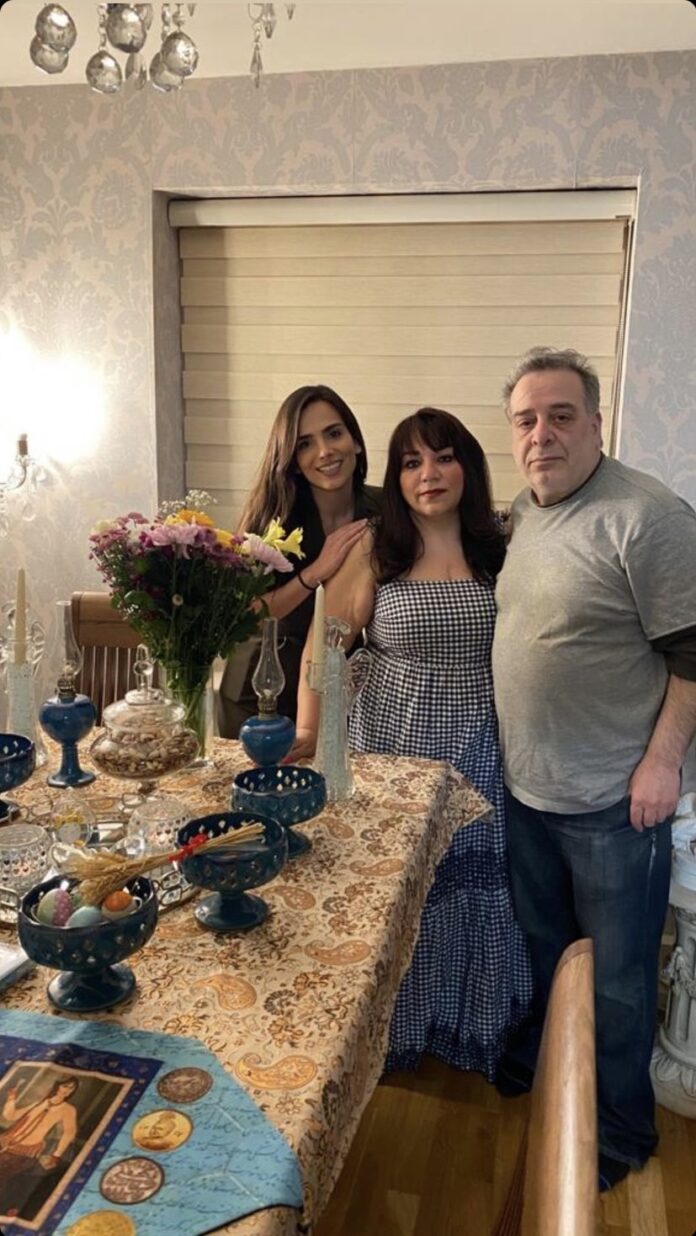Persian New Year has always been one of my most fondest times of the Year. Such a vibrant festivity where it lasts up to 13 days. It’s a Time where Family come together, spread cheer, and get ready for the New Year…But as the spark for my last post… I realised I didn’t know much. I was merely just participating in it because it was important for my family and it looked “Fun”. However there is so much to this tradition that just what it looks on the surface.
So as part of my New Tradition, is to find out the “WHY” we do certain things – What better place to start from than my own culture.
Just like you, I am also a beginner to learning and sparking my curiosity for this subject. Please bear in mind, all the information is merely from my own findings, research and speaking to people in a short space of time. So, I may have not covered everything this year, but I will be adding it to more as I become more knowledgeable.

What is Norouz? and Why is it Celebrated in March?
Persian New Year (Norouz) marks the end of the old year and beginning of a New One. The Definition of Norouz, literally means New Day. It works in harmony of the Rebirth of Nature, which is the Official First Day of Spring.
The New Year occurs on the day of the vernal equinox – not only that, the New Year actually Begins the second it does, universally. So it isn’t at the stroke of midnight. The equinox usually falls between either 19th-21st March and this year it landed on the 20th March and I celebrated it at 10:23am – Tulum Time, whereas my family in Iran celebrated at 19:03pm and in the UK, it would have been at 15:32pm.
The United Nations formatting designated Norouz as an international Holiday in 2010.
Which Countries also Celebrate Norouz?
Iran, Iraq, Azerbaijan, Afghanistan, Tajikistan, Uzbekistan, Kyrgyzstan, Kazakhstan, Kurdistan, Turkey, Albania and India.
How long has Norouz celebrations been around? and What Year is it?
Norouz has been celebrated for over 3000 years and the origin of the story is deeply rooted in Zoroastianism. An Ancient Persian religion that predates Christianity and Islam.
As the religion has been around for thousands of years, it’s not only confined to the borders of Iran or the many versions of the Persian Empire there have been- which is why Norouz is also celebrated by millions of non-iranians around the world.
The year now, is 1401. However, this reflect the solar calendar – the Iranian Calendar starts with the prophet Muhammad’s pilgrimage to Medina.
Norouz remains to stay beloved to Iranians, and has been proved to be resilient over the years in upholding their tradition. Even after the 1979 Revolution, when ended Persia ended with the Islamic takeover. They refused to allow the new government to suppress the level to which Norouz is celebrated, resulting to its removal.
Today, it deeply engrained in the hearts of the Persians…and now you will begin to understand more why it is…
How do you prepare for Norouz?
I wasn’t joking this is a very long period of time that this celebration takes place.
People start to get ready for Norouz at least three weeks ahead of the actual vernal equinox. Iranians begin by preparing their homes. This starts with a process called “Khan-e-Tekani” – which literally means “shaking the house”.
Everyone does serious spring cleaning, rearranging their homes, ridding of any unnecessary clutter and any lingering dirt or germs from the past year. Most would normally donate many of their items, to clear out space in order to bring in the new.
They can either make new clothes, or go shopping to buy in time, and start the year fresh.
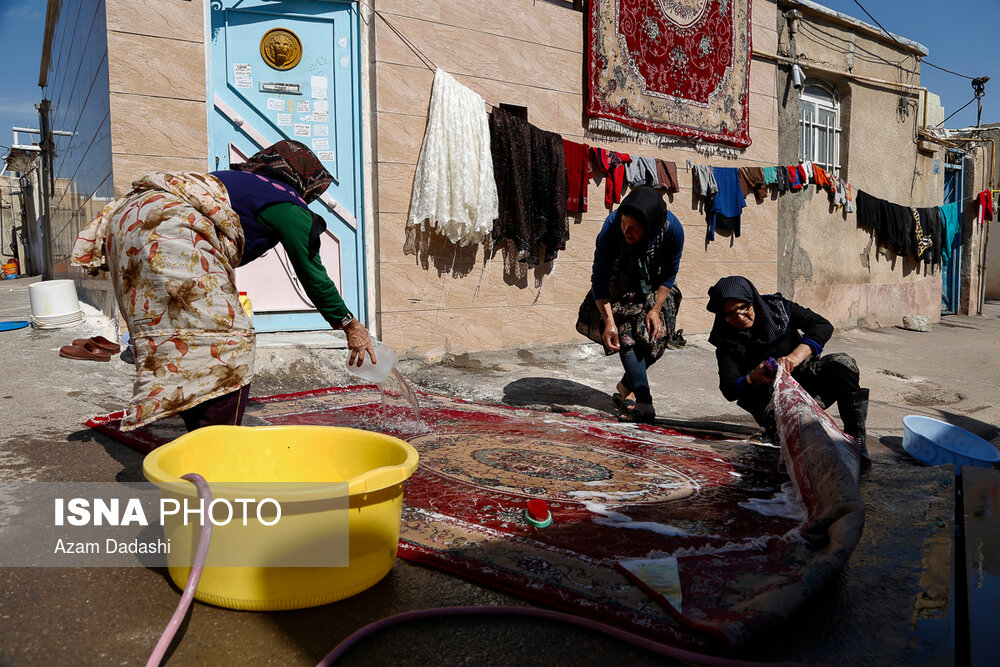
In the lead up to the actual day, families begin to set up aside space for the “Haft-Seen”.
Every item on the Haft-Seen table, symbolises a different hope for the New Year.
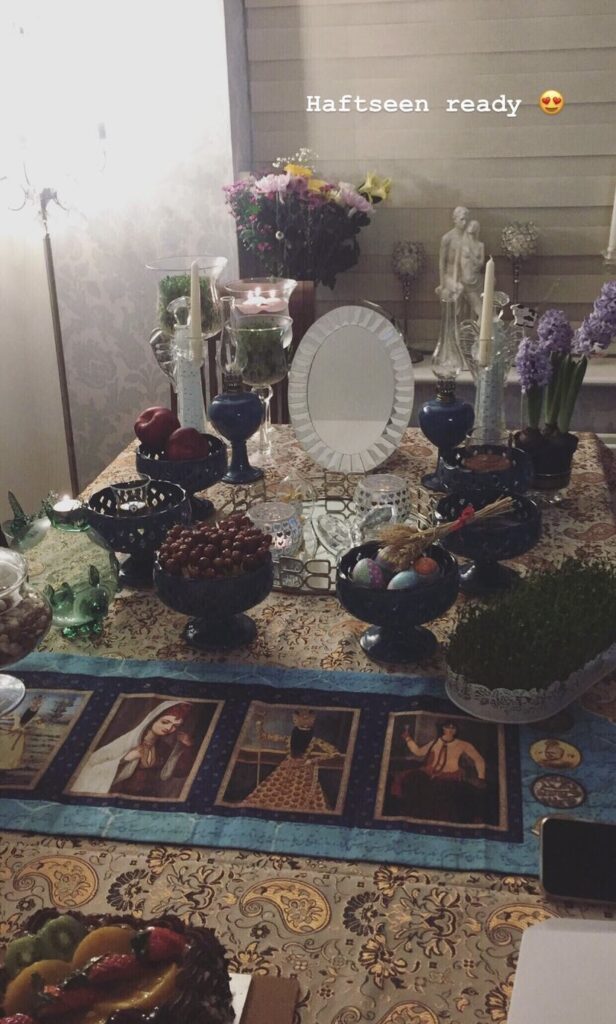
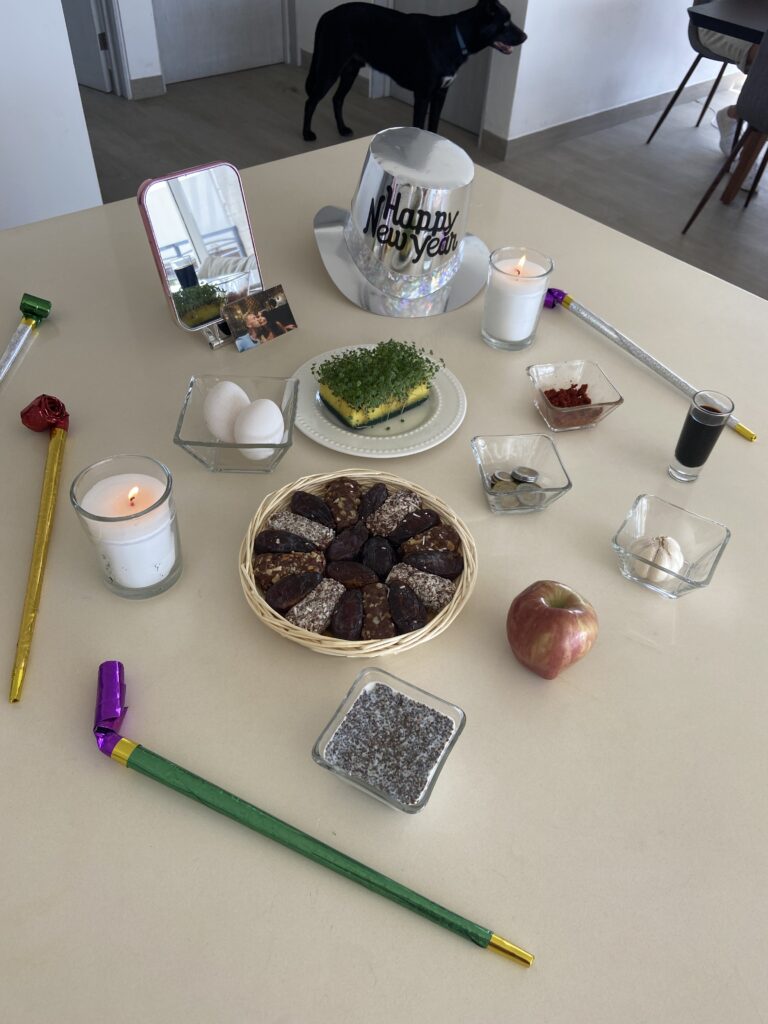
Traditionally, there are always 7 things which are always included and starts with a ‘S’;
- Sabzeh (Wheat, Barley, or Lentil Sprouts…or in my case, I managed to grow last minute Chia seeds out of a Sponge. I only had 4 days to do it. LOL) They would typically need a little while longer to grow properly and watered daily. – Symbolises for ReBirth and Renewal.
- Samanoo (A sweet pudding) – for Wealth and Fertility.
However as we live in Tulum and don’t have access to typically all items you would find available in a Persian shop – we had to improvise…and resorting to making Chia Pudding (with milk). - Sib (Apples) – for Beauty and Health.
- Seer (Garlic) – for Medicine and taking care of Yourself.
- Senjed (Dried Fruit) – for Love.
- Serkeh (Vinegar) for Age, Wisdom and Patience.
- Sumac (A Persian spice made from crushed sour red berries) – for the Sunrise of a New Day.
Whilst these are the main components of the Haft-Seen, the tradition has evolved to include other sentimental and meaningful items such as:
- A Mirror- symbolises Reflection.
- Candle- for Light, Energy and giving of warmth to Others.
- Coins- for Prosperity.
- Coloured, Painted Eggs- for Fertility.
- Sonbol (Hyacinths) for Beauty and Fragrance.
- And for those who are motivated to care, and look after – add several live Goldfish in a bowl to represent New Life. (We stopped buying them the last few years as they would just die days after 🙁 )
A box of Shirini (Sweet pastries) to bring sweetness in your life.
Once, you have all the main essentials – the Haft-seen is yours to customise. Depending on your faith or beliefs, many would either add a Holy book like the Quran, or add a book that is dear to them e.g. Poetry by Hafez, One of Iran’s most beloved poets.
How do we Celebrate Norouz?
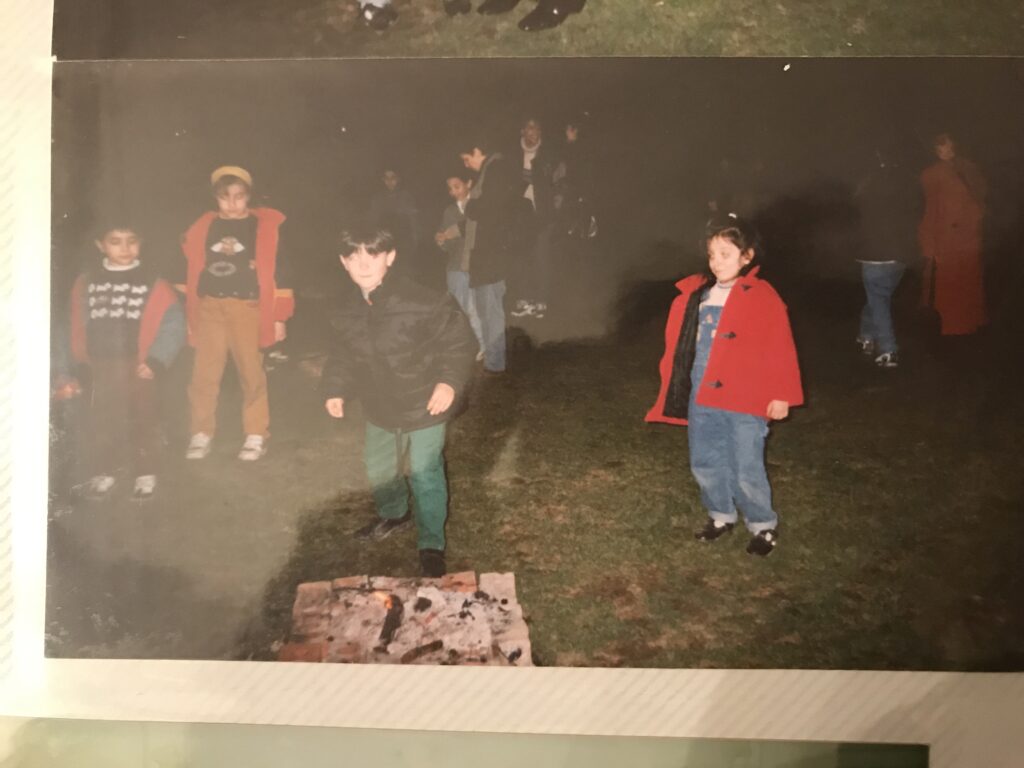
On the last Tuesday of the Year, People come together and celebrate Charshambe Suri.
The atomsphere is Electric. Bonfires are lit in public places and jump over the fire saying “Zardi-ye man az toh, Sorkhi-ye toh az man!” This translate to “Give me your beautiful red colour, and take back my sickly pallor”.
This tradition echoes Norouz’s theme of Renewal. To cleanse/put the past behind you, so you can look forward to starting the New year fresh.
This year, Charshambe Suri was on the 15th March. I celebrated it with my partner, first time away from family and recreated it at my new Home, in Tulum. It was magical. And so special being able to welcome him more into my world, of how I grew up. To see him learn and understand more about my history, culture, and values. It brought us even closer together. ** See Below, for New Traditions that we’ve created together this year.**
Norouz Day Celebration:
The beginning of the 13 Day Celebration starts on New Year (Vernal equinox). Families dress up in their new clothes and gather together around the Haft-seen table.
As the family awaits for the moment of Spring – they place a sweet in their mouth and coin in their hand. At the moment of transition into New Year or “Sal-e-Tavil”. They Embrace each other and Exchange Gifts. Normally, elders give the “Youngers” (children) cash gifts, which also becomes an incentive for them to go “Eid Didani” to go round to other family members to collect their money…as you can imagine, it can become a bit boring for them to do this for a long period of time…
Food is very important to the Culture of Persians and they great pride in preparing, cooking and serving to their families, so of course – it doesn’t fall short on this special day and the theme of having Meaning in everything they do, also continues here.
It is part of Norouz tradition to eat Sabzi Polo ba Mahi (Herbed rice with fish). The herbs in the rice are a Symbol of Rebirth. And the Fish(Mahi) symbolises Life.
(Video is from 2 years ago at my mothers x)
Over the Next 12 days…
Over the Next 12 Days (told you, it’s a long celebration! ahaha), friends and family visit each other at their homes. Where they Take flowers and sweet etc, and generally go about remembering and reinforcing their bonds.
During the Norouz Holidays, people are expected to pay house visits to one another, mostly limited, family, friends and neighbours.
In the form of Short house visits, one another will visit and also pay back the visit in return within the 12 days. Typically, the younger visits the Older first and then older return the visit later. They have to be typically short otherwise, they may not be able to visit everyone on their list.
As we’ve seen so far, Norouz isn’t just about getting rid of the old, holding onto sadness…it’s about Celebration AND Appreciation of LIFE. The Persian and Zoroastrian culture holds deep values on remembering what is truly important during this time. Family, community, love and a deep respect for Tradition. The ceremonies surrounding Norouz helps us to reinforce this and stay connected.
Which brings us to the last day of celebration…Where we close the chapter of remembrance, appreciation of the past year…and get EXCITED for the year ahead. Welcoming endless possibilities with a new blank slate.
What is Sizdah Bedar?
On the 13th and last day, is called Sizdah Bedar. This is a phenomenal day and just remembering of my childhood and past memories, makes me smile so much.
Families, friends, neighbours go out in nature and gather in groups. Usually, in the UK – we would go to a public park that we knew many others from the Iranian community would be there. Either it being an organised event or can be lowkey – in the middle of the fields.
Families would set up either a BBQ or a ready made picnic. The idea of the day is to feast, play, and dance in abundant. We would share food, laugh, play games with the adults and children. And dance the day away with vibrant music.
On this day, people throw their sabzeh into the nature or running water as a symbolic act of making the nature greener. And dispose of the bad luck that the sprouts has been in collecting in the household.
Interesting knowledge I have come across that did not know before:
The 13th day, stems from the Ancient Persians belief that the 12th constellations in the zodiac. control the months of the year. And each ruled the world for a 1000 years, and the end of which, the Sky and Earth collapsed in chaos. Hence Norouz lasts 12 days and on the 13th day, represents the time of chaos. Where family puts war aside and avoid the bad blood associated with the number 13 by going outdoor, and having picnic and parties.
Extra Bonus…
As well as honouring the old, to savour the beloved traditions, respecting the culture to follow what resonates with our hearts. We have also, made it part of our own tradition as a couple, to Create Our Own.
- To be creative and do things that has REAL meaning to us, as a new couple. Especially when wanting to Bring each other closer to our own, individual Worlds.
- Sometimes, following own cultures can feel enclosed to others around you. Who don’t feel part of it, due to reasons like different nationality, religion, ethnicity etc…
- However it has more meaning to me, that I am be able to share what’s Special to me – to the people that I love and have near to my heart. It’s a way to understand me but most importantly, to build the bridge between us. To feel closer, included, wanted by one another. By Alex taking an interest in learning and embracing my culture, I feel Seen. And by sharing my old/families culture with Alex, he feels accepted and welcomed.
So we have started to find ways to do this as a couple and to make it easier to adopt each others culture by also adding our Own traditions:
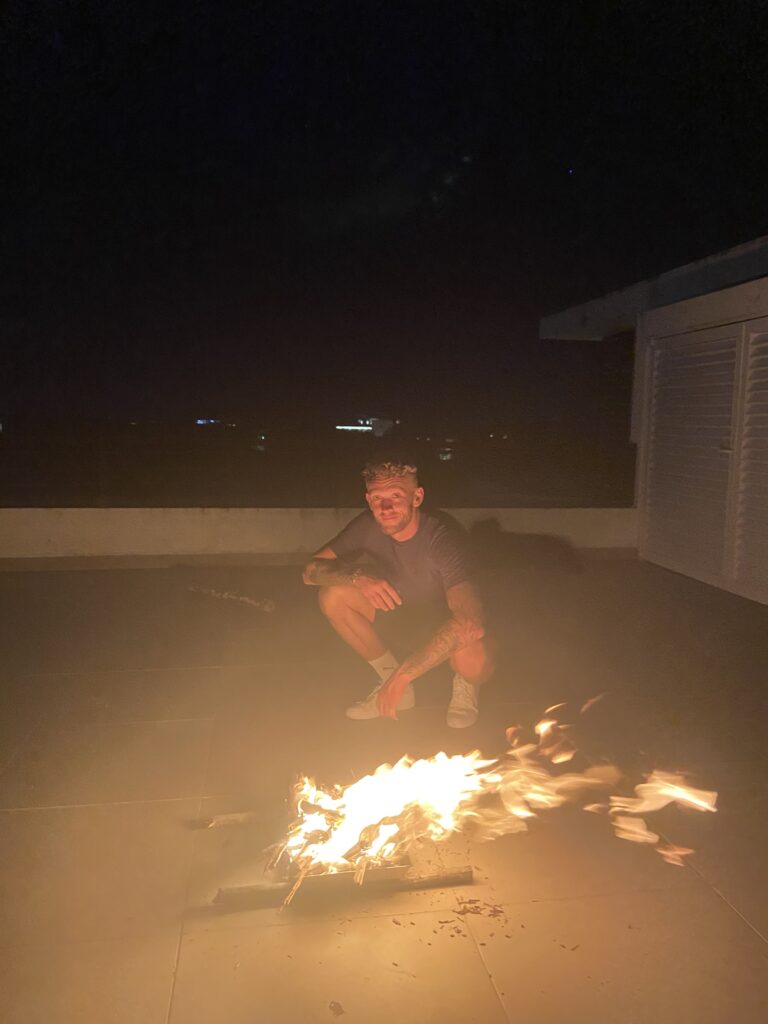
- e.g. For Charshambe Suri; as we had already celebrated New Years on December 31st and set out our goals for 2022. We used this as an opportunity, to pause, slow down and self reflect on them. This was my boyfriend’s idea. It actually touched my heart to see his involvement to make the experience more special for the both of us.
- First, we gathered around the burning fire and said what we wanted to let go of this year. What we wanted to release of ourselves, in order to move forward to the future. And then we set an intention of what we want to see or do more of. And What we wished for humanity and our loved ones.
- Afterwards, we reflected on our goals. Not to add more onto what we already set for ourselves… But to appreciate and be proud for one another. To acknowledge our achievements and how far we’ve come so far.
- Normally, we would have Ash-e-Reshteh (noodle soup with deliciousness inside) but as we’re living in Tulum- It’s quite limited on finding all the ingredients that is required for Persian Cooking. However, no time for excuses…so we make DO with what we have.
And so, we made Fesenjoon, one of my all time favourite dishes. This was soothing to the soul because I was able to recreate a bit from back Home. My mother’s cooking that I fell in love with.
Food is such an important part of our Culture. It’s how families were brought together. My mother who poured so much LOVE into her cooking. You could just tell but how delicious her food was…and I know we say that about all mothers. And God bless those who do. So, it brings me so much joy by the simple thought of how much care and energy went into spending hours to cook to pure perfection.- So it was my honour this time as an opportunity…to actually learn how to Cook this beloved meal. For my new family, Alex to also enjoy, what I had for most of my lifetime.
Norouz Day
As it’s my first year away from family and in my new home, Norouz felt very different to me. So we tried as much as we could to get all the ingredients…some we had to improvise on…Like the sponge LOL. But it just doesn’t feel quite the same without your family and friends around you.
You realise that it’s FAMILY that make the experience for you. For it feel so rich and sweet to have such love in your life. However it’s a choice I made temporarily to be away from them, in order to build a beautiful life, in a part of the world that I feel is right for me.
All from scratch.
Instead of Victimhood, I chose to Empower myself. So, I created an Event – as part of Humanity Marshals that I built in the UK. “Come Dine With Us- Persian New Year Special”.
This was my chance to hold myself accountable and actually Learn what I had been blessed to experience and recreate it for my New Community. It was my turn to now pass on the traditions. So I spent time researching on the history, learning more about my culture. Hence this blog post I have put together, so that I can actually be able to share with others when people ask: “What is Persian New Year?”
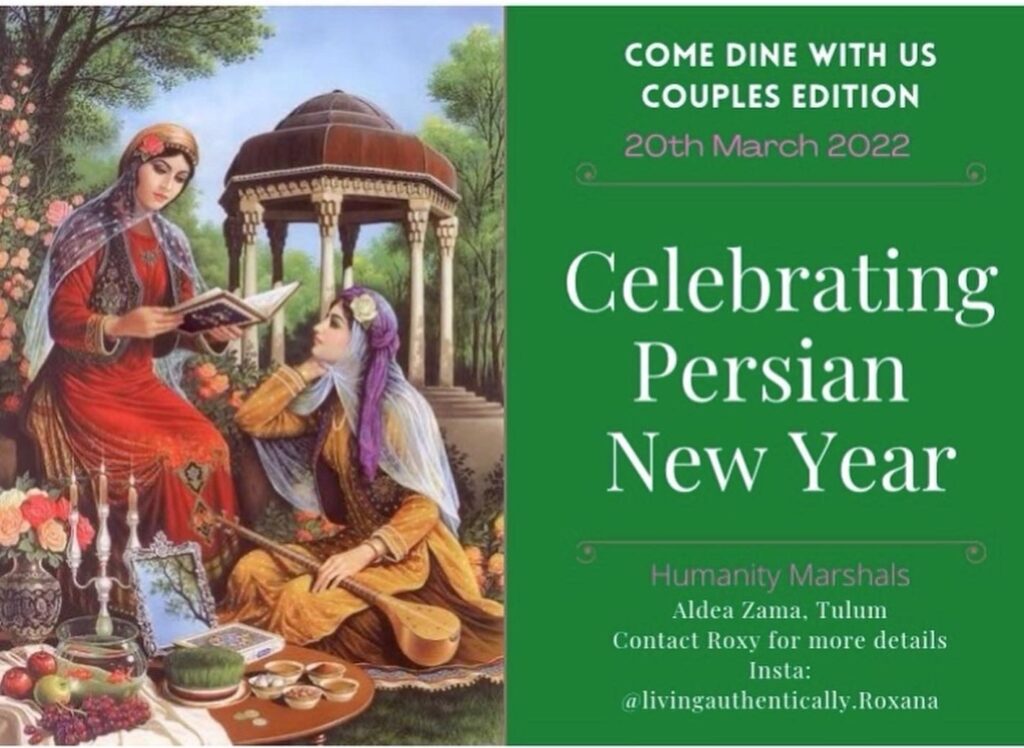
So, I put it out there, to the universe and see what would happen in return. My initial idea was that I could use it as an opportunity to meet new people within Tulum. A new, fun way of interacting with people. Something that is quite alien to the norm of making new friends.
However I understand that most people that come to Tulum, have an intention in mind of how they would spend their time. We didn’t expect much from it as we didn’t hear any response…UNTIL Norouz Day. A beautiful couple from London found our event and wanted to spend Norouz with us, as Sarah was also Persian and was far from home/family, on holiday.
Our event didn’t go as accordingly but we still met up and went to the closest restaurant that represented Persian food. As a result of this, we ended up creating a beautiful friendship and have met up several times, making more memories.
- For the actual day, Sizdah Bedar, we actually went on a tour boat trip…and so much happened that day, where it either didn’t go to plan or found bad luck caught up with us. Our poor day, Bear was also attacked by another stray dog 🙁 Which makes me believe that the superstition behind the 13th Day is True (as noted earlier).
However, we made up for it for the next day. We were creative in how we spent the day. There isn’t much of a BIG Iranian community here but that didn’t stop us. And in the spirit of bringing ALL community together, we invited our closest friends – which are our friend from UK who is visiting and two new friends who met through the event I put together.
We went to Paradise Beach, had a fruit picnic, sitting in the glorious sun. And recreated some of the Persian Culture here – by bringing the upbeat energy, dancing, laughing, listening to music…aswell as new traditions…
See my reel on instagram for the whole clip.
- Thank you for reading this. It means everything to be able to complete this and share it with the World,
- Roxana x

